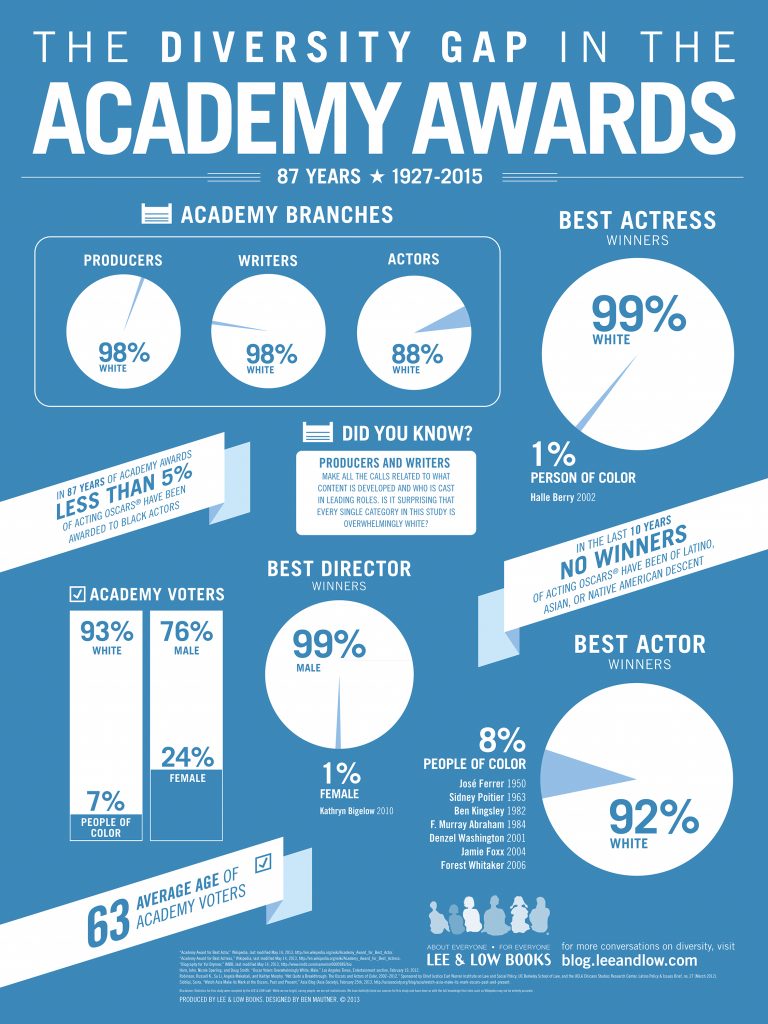Note: This infographic was updated to reflect winners through 2015.
The Academy Awards will soon unveil the very best in filmmaking in 2014. As the prediction chatter ricochets around the web, our curiosity about the level of racial and gender representation of the Academy Awards is the focus of our next Diversity Gap study. We reviewed the Academy’s entire 85-year history and the results were staggeringly disappointing, if not surprising in light of our past Diversity Gap studies of The Tony Awards, The Emmy Awards, the children’s book industry, The New York Times Top 10 Bestseller List, Sci-Fi and Fantasy Films, US politics, and Silicon Valley where we analyzed yearly/multi-year samplings and found a disturbingly consistent lack of diversity.
Since the Academy Awards was founded 85-years ago:
- Only one woman of color (1%) has ever won the Academy Award for Best Actress
- Only seven men of color (9%) have ever won the Academy Award for Best Actor
- Only one woman (1%) has ever won the Academy Award for Best Director
An interview with independent filmmakers helps give a glimpse of the current climate of Hollywood today.

Gina Prince-Bythewood is a writer/director for television and film. Her credits include Love and Basketball, The Secret Life of Bees, and the upcoming film Beyond the Lights, which will be released November 14, 2014.

Iyin Landre is an American actress/filmmaker currently living in Río de Janeiro, Brazil. Her first feature film, Me + You, is now in pre-production.

Jason Chan is an Australian actor/writer/director and one of the founding partners of BananaMana Films, a creative production company based in Singapore. BananaMana recently completed its first thirteen-episode TV drama, What Do Men Want?, and is gearing up to start season two and a film in 2014.
 Kelvin Yu is a Taiwanese American writer currently working on the Fox animated series Bob’s Burgers. A Los Angeles native, Yu studied theater and communications at UCLA. His acting credits include Milk, Star Trek, Studio 60 On the Sunset Strip, and The Shield. He also has a small white dog named Yuki that used to live in New York. Neither of them is fixed.
Kelvin Yu is a Taiwanese American writer currently working on the Fox animated series Bob’s Burgers. A Los Angeles native, Yu studied theater and communications at UCLA. His acting credits include Milk, Star Trek, Studio 60 On the Sunset Strip, and The Shield. He also has a small white dog named Yuki that used to live in New York. Neither of them is fixed.
Jason Low: Gina, since writing and directing your independent film Love and Basketball, how has the climate of filmmaking changed? Is it easier or more difficult to get a film made that captures your ideals AND that is more accurately representative from a gender and minority perspective?
Gina Prince-Bythewood: Unfortunately it has gotten considerably harder to get a film made that has non-white leads, or a female lead.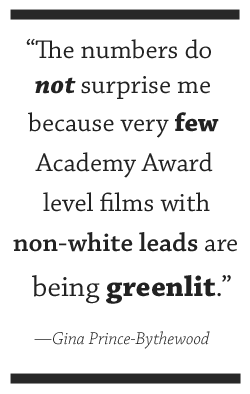
JL: Iyin, in our initial conversation, when I asked you if you felt you had a shot at roles that were ethnically ambivalent, you mentioned that black actresses had a better shot at these types of roles because they are seen as American, especially to international audiences, whereas Asians are not seen as Americans. I found this really interesting. Perhaps you could expound on your response while including your observations about the international marketplace and African American actresses.
Iyin Landre: Man, this is such a complex and at times mind-boggling subject, the issues of race and identity. I’ve actually been thinking about it a lot since I got to Brazil, probably because I’ve had to deal with it more. I think to an international audience, Asian Americans are not perceived as being American. We are perceived as being Asian, from the motherland, speaking Japanese (or so I’ve encountered).
I don’t know that an African American actress would have to defend her nationality as much as I do, but I mean, hopefully all this changes when people meet me and they begin to wrap their minds around how I can look Asian but be American. (Of course, the grand irony in all of this is that I’m having these discourses about my “origin” in perfect English!)
JL: Gina, when you look at the Diversity Gap in the Academy Award infographic, do the numbers surprise you? If not, what are some of the mitigating factors that explain why the statistics look as they do?
GPB: The numbers do not surprise me because very few Academy Award level films with non-white leads are being greenlit. Until this changes, the abysmal numbers will not change. The box office drives which films get greenlit. The hope is that with this year’s success of a variety of films with African American leads, Hollywood will be more open to taking chances.
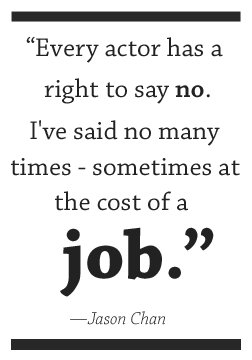 JL: Jason, you have a number of war stories to share about running up against race related obstacles during your acting career.
JL: Jason, you have a number of war stories to share about running up against race related obstacles during your acting career.
Jason Chan: After I completed medical school and worked in the hospital system for about four years, I got into drama school at NIDA (National Institute of Dramatic Arts). NIDA was made famous by many of its graduates: Mel Gibson, Judy Davis, Cate Blanchet, Baz Lurhman. We noticed even in drama school that ethnic actors were not only a minority, it was also rare that they were given lead roles. I fought for my chance at a lead in my final year and was successful. My own Australian agent, ICS, recounted to me a story about a meeting with casting directors. At the meeting, actors’ agents were told that if a role was described as “31 year old, Lawyer,” it meant “31 year old, Caucasian.” The default is always Caucasian unless something else is specifically asked for. Another friend of mine, of Indian descent, had been cast by the director of a new Australian TV drama. The network apparently had problems with his role and asked why they couldn’t cast “someone white” in his place, since the role wasn’t specifically Indian. This is the problem.
It is pretty clear that certain countries remain extremely Anglo-centric, and certainly in Australia that was a problem for me. That’s why I moved to Asia—Singapore specifically. At first I didn’t like the move. It felt like I had somehow given up or failed, but there was more to it. This short helps to explain part of it.
I’ve heard many Asian Australian actors say “I can’t stand it when they ask me to speak in broken English in a bad Asian accent.” My answer to them is, “Don’t do it then. You’re just perpetuating a false stereotype.” Every actor has a right to say no. I’ve said no many times, sometimes at the cost of a job.
When I played the green power ranger in Power Rangers Ninja Storm, I spoke at length to the head writer/ producer and the costume department to subvert the stereotype. I played the geeky, computer genius that was going to become the final power ranger of the team. I told them I’d only do this if I could subvert the stereotype by being a cutting, sarcastic, charming geek who then becomes the most powerful of the group. They were very responsive to my concerns about stereotype and worked with me to develop the character. The green ranger ended up single handedly saving the team from near destruction during the series. I now have many ethnic fans who see me (or my character) as a role model.
When I first started auditioning in Singapore I was amazed by my own reaction to getting lead roles. I would think, Wait, I can’t have the lead role—I’m Asian!! I was used to auditioning for minor roles or ethnically specific roles in Australia. Among my Asian actor friends almost all of them will say, “I’m sick of being asked to speak in broken English.” Singapore was obviously different and it has allowed me to grow as an actor and to develop my own language and stories.
***Other Ways to Get Film and Media Projects Made Outside of Hollywood***
JL: Iyin, how did the independent film Me + You come to be?
IL: I was thinking about this the other day as I turned in quarter steps in my mini shower here in Brazil, tracing the experiences that have led me here.
I’ve always known that I wanted to be more than an actor. I’ve always wanted to create, tell my own stories. After acting in LA for several years, I realized that there was a ceiling to the opportunities that were coming my way, especially being an Asian American actress. So I took things into my own hands and learned how to write, produce, and direct. This way I could make my own movies and not have to wait for someone else to cast me in one.
During a screenwriting class, I came up with the premise for this feature for which I’m currently in pre-production. The story is about an American girl who travels to Brazil and falls in love with a drug dealer from the favelas. It’s gritty, thrilling, exciting—everything that I love about independent cinema.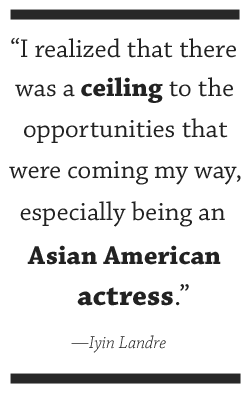
After I finished the screenplay, I brainstormed the best way to raise money to shoot the feature. Since I had some airline miles that I’d been saving, I decided to fly down to Brazil by myself and shoot a trailer for the movie. I felt that if I could show what the movie would look like, feel like, I would be able to raise the funding for it.
JL: Iyin, did Kickstarter play a major role in helping raise funds to finance your independent film?
IL: Kickstarter was a whirlwind. Originally I didn’t want to do Kickstarter because I knew how tedious it would be, and how awkward it is to ask friends for money. But a few other factors came into play, and in mid-August, I launched my Kickstarter campaign. I set the goal at $75K and it did indeed become a full time job, emailing, reaching out, Facebooking, Tweeting. I raised close to $15K through my social network the first three weeks or so, but with not many days left, I had to re-strategize. I dug to the core of why I was making this movie, what was spurring me on, and decided to shoot a new video. We emailed the new video out to several websites with big followings and Upworthy.com picked it up with forty-three hours left in the campaign. It was a true miracle how we met our goal, raising a whopping $62K in the last two days.
JL: Jason, tell us about your new production company, BananaMana Films.
JC: I have decided to take up the fight from this part of the world. The best I can do is to produce, write, and direct content that puts Asian faces on the screen. People need to see faces of all color on TV and in film so they become the norm. We’ve established a production company, BananaMana Films, which has just completed it’s first thirteen-episode TV drama. My business partner, Christian Lee, and I wrote, directed, and produced the series and it will air on local TV next year. Hopefully it will be successful and we’ll get the opportunity to keep producing. So far the feedback has been tremendous.
With our production company we can now produce content that puts Asian faces on TV and hopefully soon the bigger screen. We do it without question or apology. Asians are not the minority and they don’t speak in a “funny” way. They speak English perfectly like everyone else and they can play any role. The key is to cast color blind, never to look at race as a deciding factor. In our TV show we have Indian, Malay, and Chinese actors, basically anyone who can act the part.
JL: Kelvin, Gina have you seen any working models of production companies that are (a) doing something to move the needle on promoting more diverse projects, and (b) commercially successful?
GPB: I think the independent world is still the best incubator of diverse projects with diverse casts. However, with continued success, studios will follow the trend.
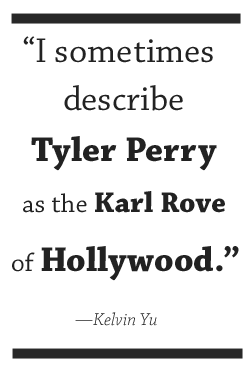 Kelvin Yu: Maybe the best current example of how the market and diversity can dovetail is Tyler Perry. I sometimes describe Tyler Perry as the Karl Rove of Hollywood. It’s a joke, of course, but what I mean is that both guys, in a sense, took advantage of a previously untapped well. In Rove’s case, first in the early 1980s with Lee Atwater and then eventually with George Bush in 2000, he took the Republican Party and essentially said to them, “Listen, there is this small, but extremely fanatical group of people way out on the outskirts. Come with me and I will take you to the promised land.” We all know what happened next. The party bet the house on a fringe demographic that was passionate and easily galvanized. And it worked. Those people turned out to be all they needed to obtain a slim majority of the vote.
Kelvin Yu: Maybe the best current example of how the market and diversity can dovetail is Tyler Perry. I sometimes describe Tyler Perry as the Karl Rove of Hollywood. It’s a joke, of course, but what I mean is that both guys, in a sense, took advantage of a previously untapped well. In Rove’s case, first in the early 1980s with Lee Atwater and then eventually with George Bush in 2000, he took the Republican Party and essentially said to them, “Listen, there is this small, but extremely fanatical group of people way out on the outskirts. Come with me and I will take you to the promised land.” We all know what happened next. The party bet the house on a fringe demographic that was passionate and easily galvanized. And it worked. Those people turned out to be all they needed to obtain a slim majority of the vote.
In an analogous way, I think Tyler Perry emerged about ten or fifteen years ago by introducing Hollywood to a market that it never even realized existed. Prior to Tyler Perry, the African American movie going profile catered to urban interests (read Hip Hop and gang-related). Studios assumed black movies were New Jack City, Friday, House Party and Juice. By the time Perry comes around, he’s educating the studios that there is a black middle/upper class. They are family oriented, socially conservative, and often religious. They love comedy, sometimes they like cross-dressing grandmas, and most important, they go to the movies. A lot.
Perry was right. And it paid off. He can make a movie for less than ten million dollars that will gross twenty million opening weekend, and he caters to an audience that was previously undiscovered. It’s like he’s pulling dollars out of the air.
But for the purposes of our discussion, this is a good example of the intersection of profit and diversity.
JL: Jason, What are some things that people can do to support non-Hollywood projects and encourage diversity in their viewing habits and choices?
JC: We need more people of minority races creating content that is rich in diversity and culture.
We need to watch films of other countries and support films from countries that don’t own the distribution network. Some of the best films in the world are from Japan and Korea, and yet they have limited distribution because Hollywood controls most of the world’s cinemas. This is changing with the internet. I would encourage everyone to watch and share films from all countries to get a more balanced view of the world, and to see that there is a thriving film and TV industry outside of Hollywood. In fact, it’s more than thriving. In my opinion, films from Asia are shaping many of the films coming out of Hollywood. Korea in particular is redefining storytelling all the time. The Koreans have the most refreshing TV dramas I’ve seen in a decade.
We need to support minorities going into the arts. This can only benefit the depth and breadth of content that gets made.
Finally, don’t support films with stereotypes. If you see stereotypes in a film, talk about them and don’t stand for such depictions of people of color. Stereotypes are the seeds of racism.
***
Read our 2015 follow up post with updated numbers.
This is not an isolated incident, but a wide reaching societal problem.
Read more Diversity Gap studies on:
The Tony Awards
The Emmy Awards
The children’s book industry
The New York Times Top 10 Bestseller List
US politics
Sci-Fi and Fantasy Films
Silicon Valley
Further resources on how to teach content and visual literacy using Lee & Low Books’ infographics series on the Diversity Gap:
Using Infographics In The Classroom To Teach Visual Literacy
For press inquiries or permission to reprint, please contact Hannah Ehrlich at hehrlich[at]leeandlow[dot]com.








